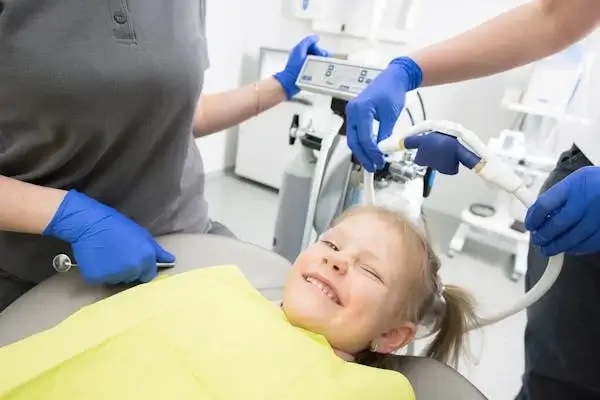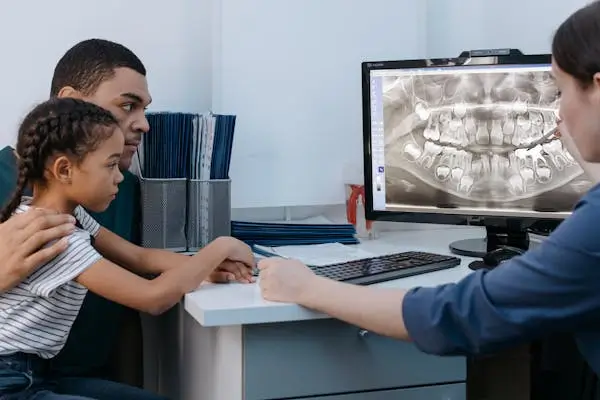As parents, we dedicate ourselves to ensuring our children's well-being, don't we? We meticulously plan their diets, encourage physical activity, and tirelessly research the best schools. But amidst this whirlwind of responsibility, there's one crucial aspect of their health that sometimes gets overlooked – their oral health. And right at the heart of maintaining those precious little smiles is the pediatric dental exam. It’s not just a quick peek into their mouths; it’s a foundational step in their overall health journey. Think of it as laying the groundwork for a lifetime of healthy habits and a beautiful, confident smile, a philosophy well understood by practices like ARC Dental Health. A pediatric dental exam is a comprehensive checkup tailored specifically to children’s dental needs. It's more than just counting teeth—it's a complete oral health screening. Think of it like comparing training wheels to a mountain bike. Pediatric exams are gentler, simpler, and filled with extra patience and care. They’re designed to ease kids into the dental world. The focus is early prevention. Dentists aim to detect painful cavities, track oral development, and teach good habits—before problems arise. Here’s a simple rule of thumb: Schedule your child’s first dental visit when the first tooth appears, or by their first birthday—whichever comes first. Many pediatric dentists begin with a friendly walk-through of the office. This helps children (and parents) feel safe and familiar. You’ll meet the dental team—often bubbly, bright, and fantastic with kids. This moment builds trust. You’re encouraged to stay close, hold hands, and offer reassurance. You’re not just allowed in—you’re essential. Dentists ask about feeding habits, thumb-sucking, and past dental experiences—because every child is unique. This involves looking for signs of decay, gum disease, or abnormalities. Only when necessary, and always with minimal radiation. X-rays reveal hidden issues, like cavities between teeth or unerupted teeth. A gentle and quick cleaning removes plaque. A fluoride application strengthens enamel—think of it as armor for tiny teeth. Is your child fussy, drooling, or chewing on everything? Your dentist can confirm if teething is to blame. These habits are common—but prolonged use may affect bite alignment. Dentists offer advice on preventing “baby bottle tooth decay,” especially if bottles are used at bedtime. You’re the superhero here—your calm presence can work wonders. No question is too small. This is your chance to bring up anything—from brushing struggles to diet. Dentists first explain what will happen, show the tools, and then gently perform the treatment—building comfort step by step. Some offices play cartoons, give out stickers, or tell silly jokes… because happy patients = successful exams. Modern pediatric dentistry avoids scary tactics. Respect and kindness are the new standard. Most children have a full set of 20 baby teeth by age 3. It’s important to monitor how and when they erupt. Around age 6, primary teeth start to fall out. By 12–13, most permanent teeth are in place. Your dentist checks how your child’s jaws and teeth are forming—this can catch orthodontic issues early. Sugary snacks and poor brushing can lead to tooth decay—even in toddlers. Bleeding or red gums may signal gingivitis… even little mouths aren’t immune. Overbites, underbites, and crowding may be spotted early and addressed with interceptive orthodontics. Your dentist will suggest the right toothpaste amount—usually a rice-sized smear for toddlers. Sealants protect deep grooves in molars from decay… like a raincoat for the teeth. Brushing twice a day and flossing once can prevent most cavities. Start a chart and make it fun! Sticky candies and sodas can erode enamel quickly. Encourage crunchy fruits, cheese, yogurt, and water over juice or sugary cereals. Avoid prolonged bottle use or letting your child fall asleep with milk or juice. These help your dentist see the big picture—past, present, and future. Spotting trends can lead to timely interventions. Crowding or bite issues are easier to manage when caught early. The dentist will assess the injury and offer immediate care or pain relief. Severe toothaches, swelling, or broken teeth warrant urgent visits. Options include nitrous oxide (laughing gas), oral sedatives, or IV sedation—each suited to different needs. Trained pediatric dentists follow strict protocols to ensure your child’s comfort and safety. Say “cleaning” instead of “drilling.” “Special chair” instead of “exam table.” Keep it simple and calm. Consistency and gentle exposure work wonders. Never use the dentist as a threat. Turn visits into adventures… with post-visit treats (non-sugary, of course!). Faster and safer for tiny mouths. You can see what the dentist sees—no more guesswork. Everything is designed with your little one’s comfort in mind. Make brushing a non-negotiable part of waking up and winding down. Stickers, stars, or small prizes go a long way in forming habits. Look for warmth, patience, a child-friendly environment, and experience with pediatric patients. Children should see the dentist every 6 months—more often if they’re at high risk for cavities. These regular checkups prevent problems before they start… and help create a lifelong habit of oral care. ARC Dental Health’s dentists discuss options openly, from simple fillings to more extensive care plans. Some issues, like jaw alignment or severe decay, may require a pediatric specialist or orthodontist. At A.R.C. Dental Health in West Covina, CA, we don’t just treat teeth—we build relationships. We believe that patient education is a vital part of treatment, empowering families with knowledge. We are located at 1000 Lakes Dr # 405, West Covina, CA 91790, United States. We are open Monday and Wednesday from 9 AM to 1 PM and again from 2 PM to 5:30 PM. On Tuesday and Thursday, we are open from 9 AM to 5 PM. We are closed on Fridays, Saturdays, and Sunday Give us a chance to serve you. From preventative care to dental education, A.R.C. Dental Health is proud to provide quality dental care services in West Covina with a heartwarming touch. Contact us today. A pediatric dental exam isn’t just about teeth—it’s about trust, growth, and lifelong health. Start early, stay consistent, and work with a caring team like A.R.C. Dental Health to guide you through every smile milestone. Yes—most pediatric dentists encourage it, especially for younger children. Your presence is comforting. Typically, 30–45 minutes, including cleaning and consultation. Pediatric dentists are trained to handle all kinds of behavior gently. Don’t worry—it’s more common than you think. Yes, digital X-rays used today emit very low radiation and are considered safe for children.
What Is a Pediatric Dental Exam?
How It Differs from an Adult Exam
The Goal of a Child-Focused Checkup
When Should Your Child See the Dentist?
First Visit Timing (The “First Tooth or First Birthday” Rule)
Frequency of Exams Based on Age and Risk
What to Expect During the First Visit
A Tour of the Office
Meeting the Dentist and Staff
Parental Involvement in the Process
Components of a Pediatric Dental Exam
Oral Health History
Visual Inspection of the Teeth and Gums
X-rays: When and Why They’re Taken
Dental Cleaning and Fluoride Treatment
Common Concerns Addressed During the Exam
Teething Issues
Thumb Sucking or Pacifier Use
Bottle and Breastfeeding Habits
The Role of the Parent During the Exam
Comforting Your Child
Asking Questions and Sharing Concerns
Child-Friendly Techniques Dentists Use
Tell-Show-Do Approach
Distraction and Positive Reinforcement
Behavior Management Without Fear
Understanding Your Child’s Dental Development
Eruption Timeline of Primary Teeth
When to Expect Permanent Teeth
Monitoring Growth and Jaw Alignment
Common Pediatric Dental Issues Found in Exams
Early Childhood Cavities
Gum Inflammation or Infection
Malocclusion or Bite Problems
Preventive Care Recommendations
Fluoride Use at Home
Dental Sealants for Molars
Brushing and Flossing Tips for Kids
Nutritional Counseling and Oral Health
Sugar and Acid Impact on Teeth
Healthy Snacks and Drink Choices
Bottle and Sippy Cup Advice
How Dentists Track Dental Growth
Use of Growth Charts and Dental Records
Comparing Changes from Past Exams
Early Signs of Orthodontic Needs
Pediatric Dental Emergencies
What Happens if Trauma or Pain Is Found During an Exam?
When to See a Pediatric Dentist Immediately
Sedation Options for Anxious Children
Types of Sedation Used in Pediatric Dentistry
Safety Guidelines for Sedation in Kids
Creating a Positive Dental Experience
Language to Use With Kids Before the Visit
Avoiding Dental Anxiety Early On
Making the Dentist a Fun Routine
The Role of Technology in Modern Pediatric Exams
Digital X-rays and Low Radiation
Intraoral Cameras for Parent Education
Child-Safe Diagnostic Tools
Promoting Oral Hygiene Habits After the Exam
Tips for Morning and Bedtime Routines
Reward Systems and Toothbrushing Charts
Choosing the Right Pediatric Dentist
Qualities to Look For
Questions to Ask During the First Call
How Often Should Kids Go to the Dentist?
What If Problems Are Found During the Exam?
Treatment Planning for Cavities or Gum Issues
When Referrals to Specialists Are Necessary
Why Parents Trust A.R.C. Dental Health
Final Thoughts on Pediatric Dental Exams

FAQs
Should I Stay in the Room During the Exam?
How Long Does a Pediatric Exam Take?
What If My Child Won’t Cooperate?
Are X-rays Safe for My Child?